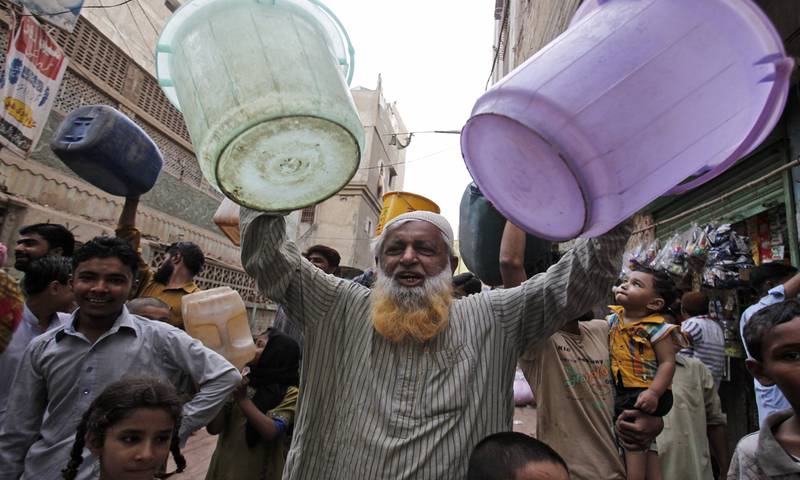Pakistan has been blessed with enormous water resources. Soon after partition, the per capita per annum water availability in Pakistan stood at 5650 m3 (cubic meter) which was more than three times the threshold value of 1700 m3/capita/annum. In the 1950s Pakistan was justifiably rated by international agencies to be a water-abundant country. In 1992 UK Fund for Population stated that availability of water commodity in Pakistan had comedown to the threshold value of 1700 m3/capita/annum. Threshold value is the level at which something starts to happen or have an effect. It may be pertinent to mention that a country with water availability below threshold value is bound to face seasonal or regular water stressed conditions.
According to the renowned Falkenmark Water Scarcity indicator, a water resource system is considered stressed if it is unable to deliver the necessary water for environment, social and economic purposes. Water availability has alarmingly declined to 940 m3/capita/annum in 2015. Such a shortage can hamper the health and wellbeing of the people and at the same time severely impact the economic development. The availability of water is expected to drop to 860 m3/capita/annum in 2020, leaving Pakistan in a state of acute water shortage. The minister for water and power Khawaja Asif has repeatedly said on various occasions that water crises are not too distant and could prove to be more crippling than the current energy crises we confront.
Water is a valuable resource that is depleting fast. Pakistan once globally known as water abundant country has turned to water-stressed state and now, without any iota of doubt, to a water scarce country because water availability per capita has dropped below 1000 m3 annually, which is the scarcity benchmark. The UN has not yet downgraded Pakistan from ‘water stressed’ to ‘water scarce’ state.
Total surface water availability in the country is 145 MAF (on average) per annum. (MAF stands for million acre feet). This water mass includes three western rivers Chanab, Jhelum and Indus in addition to the rivers Kabul, Swat, Chitral, Dhir, Sirn, Kunhar, Neelum and Poonch of AJ&K, tributaries of river Haro and Soan and many other small and large streams and nullahs of GB, KPK, AJ&K etc. Himalayan glaciers in Pakistan’s north spread over an area of 16933 KM2 contribute over 80% water to the Indus river. Surface water utilised (for irrigation) is 104 MAF. Water escape below Kotri Barrage to the sea is 30 MAF. System and transit lasses of water (evaporation and seepage of all rivers) are 145 – (104+30), i.e. 11 MAF.
Annually an average of 30 MAF of fresh water flows downstream to last Kotri Barrage to sea against the basic requirement of 8.6 MAF flow of water to Kotri determined by the international panel of experts (IPOE) in 2005 to check the sea intrusion as well as protection against environmental hazards and flora and fauna in that region. Approximately 22 MAF fresh water is lost below Kotri to the sea, and thus, annually unutilised. In other words Indus river Basin still has am additional 22 MAF water annually that can be stored.
The existing live capacity of the present storages at Mangla, Tarbela and Chashma is only 14.10 MAF. That means our storage capacity is approximately 10% of available water which is far below the world average 40%.
If we compare the dependable water storage capacities of different countries Pakistan lags behind. India’s water store can last for 220 days, Australia for 600, US for 900, Egypt for 1000 and Pakistan only for 30 days. The global standard is 120 days. Egypt built ASWAN dam of 120 MAF storage capacity and survived three years of drought comfortably without being least affected by the aftermaths of the drought.
The reasons for current water scarcity in Pakistan is simultaneous effect of the followings:
n Out is total 33 MAF annual transboundry water flows of three eastern rivers Ravi, Sutlaj and Beas from upper riparian India to lower riparian Pakistan, 9 MAF/ annum was utilised by India itself and remaining 24 MAF/year escaped to Pakistan pre Indus Water Treaty period. Pakistan had to surrender his share following the clauses of the treaty. Withdrawing from the water use rights of three eastern rivers drastically effected the per capita/annum availability of surface water.
n The surging population is another reason. The population of Pakistan at the time of independence in 1947 was 30 million and has increased to 180 million. The water availability has reduced from 5650 m3/capita/annum in 1951 to 940 m3/capita/annum in 2015.
n Had there been more dams than the three Mangla, Tarbela and Chashma huge quantum of water equivalent to 22 MAF/year would not have gone to the sea unutilised.
n Pakistan is considered a low-rainfall country with an annual rainfall of 375 mm (15 inches). More than half of the country receives less than 200 mm (8 inches) of annual rainfall thereby paving way for higher annual evaporation. Rainfall is observed mostly in monsoon months of July and August.
Construction of major water reservoirs of 22 MAF capacity on already identified sites including Kalabagh site on war footing as a national priority is the way forward. The new storages will go a long way towards improving and decreasing the yearly water availability, increasing the GDP, mitigating floods and ensuring the availability of cheap and green hydropower.






